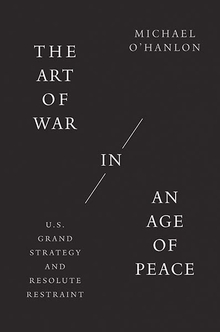Writing in USA Today, Madiha Afzal and Michael O’Hanlon argue that “the most likely outcome of any quick troop exit this year is very ugly, including ethnic cleansing, mass slaughter, and the ultimate dismemberment of the country. No one can see the future, of course, but this type of outcome seems much more likely than any smooth transition to a new government run by a kinder, gentler, more moderate Taliban.”
President Biden’s decision to bring home all U.S. troops from Afghanistan by the 20-year anniversary of the 9/11 attacks is a major mistake. U.S. troops have already been cut more than 95% since their peak levels, troop casualties in recent years have been reduced even more than that, and costs to the taxpayer have dropped by 90% over the last 10 years. There is no endless cycle of buildups, but in fact a gradual ongoing drawdown — and therefore no need to rush completely for the exits before giving the fledgling peace process a real chance.
An unconditional U.S. troop withdrawal goes beyond what the Trump administration negotiated with the Taliban in the first phase of that peace process, on February 29 of last year in Doha, Qatar. There, the United States promised a withdrawal — once several conditions were met. But they have not been. The Taliban, according to the U.N. and U.S. government, has not cut ties to al Qaeda, has not engaged seriously in the intra-Afghan peace process, and has not reduced violence against Afghan forces. (Nor has it moderated its misogynistic and intolerant views.) It has not held up its end of the bargain; we should feel no obligation to do so, either.
With U.S. and therefore also NATO troops headed for the door, the Taliban have no incentive to compromise now. Diplomatic efforts without the leverage of an ongoing troop presence are highly unlikely to result in success, because the Taliban will believe they hold all the cards in talks with the Afghan government. Our only remaining leverage is the spigot of international security and economic assistance to a new government, should it somehow be forged. But the Taliban will likely not modify their expectations about dominating any future Afghan government just for such aid — especially, one might add, when they have opium sales as an alternative revenue source.
On Face the Nation in February, Margaret Brennan asked President Biden: “don’t you bear some responsibility for the outcome if the Taliban ends up back in control and women end up losing the rights?” Biden’s response was that he bore “zero” responsibility. Regardless of his view on that matter, we should not ignore the plight or likely fate of millions of Afghan women if we pull out abruptly.
Biden’s decision may be considered a “popular” one now. But there’s little evidence that the American public is unanimously in favor of withdrawal.
No moderate Taliban
We believe the most likely outcome of any quick troop exit this year is very ugly, including ethnic cleansing, mass slaughter, and the ultimate dismemberment of the country. No one can see the future, of course, but this type of outcome seems much more likely than any smooth transition to a new government run by a kinder, gentler, more moderate Taliban.
Despite the departure of troops, U.S. and NATO military assistance in the form of money and equipment will likely continue to flow to Afghan government forces for some time, as Biden has said. So both sides will have the wherewithal to continue the fight. The war will continue, and it will move into Afghanistan’s cities, which have generally remained under government control throughout the last two decades.
As some cities fall to partial or complete Taliban control, and the Taliban exacts revenge on those it considers collaborators with the regime, there will be powerful incentives for opponents to prevent its infiltration into other cities. That could lead to ethnic cleansing and killing of Pashtun individuals as a preventive measure, since almost all Taliban come from that ethnic group.
Another consequence of all this will be an enormous refugee strain on neighboring Pakistan, risking instability in that important country of 220 million. Some might believe Pakistan could prop up a Taliban regime in Afghanistan, much as in the 1990s — but that assumption ignores how many Taliban field commanders have evolved away from Pakistani control. It also fails to factor in Pakistan’s own difficult experience with militancy and terrorism over the last 20 years. Today’s Pakistan probably does not want an exclusively Taliban-run Islamic emirate on its Western flank. It has indicated repeatedly that it supports the intra-Afghan peace process and that it will support some form of power-sharing arrangement that might emerge. That’s one more reason to give the peace process a real chance before pulling out.
Afghan civil war will intensify
If the civil war intensifies as we expect, new terrorist sanctuaries could emerge in Afghanistan, either because the Taliban invites al Qaeda in, or because the chaos of civil war creates new opportunities. President Biden says that we will keep an eye on this threat from other places. But over-the-horizon counterterrorism is largely an oxymoron, given how terrorists tend to intersperse within a population and reduce their electronic footprints in the process.
None of this is an argument for staying in Afghanistan forever, or perpetuating the war. It is about the U.S. leaving in a way that enhances the prospects for peace and stability in Afghanistan.
We may be whistling in the graveyard. But Biden and partners should try to find some way to walk this decision back, and keep some military footprint in Afghanistan for a while to come, even if under a different framework and different name. The alternative is almost certainly a greater risk not only to Afghans, but also to Americans and America, in the end.
The Brookings Institution is committed to quality, independence, and impact.
We are supported by a diverse array of funders. In line with our values and policies, each Brookings publication represents the sole views of its author(s).











Commentary
Withdrawing troops from Afghanistan: Biden’s unforced error puts America at risk
April 15, 2021